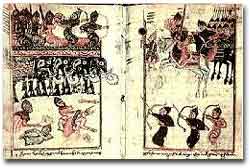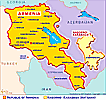
| The Republic of Armenia lies in a triangular section of the Transcaucasus, bordered by Azerbaijan, Iran, Turkey and the Republic of Georgia. With an area of 29,800 square kilometers (11,490 square miles). The capital city, Yerevan, lies on the Hrazdan River, and is home to some 1.2 million people. The next three largest cities are Gyumri (pop. 121,000), Vanadzor (pop. 74,000) and Abovian (pop. 54,000). | ||
|
. |
A land of unspoiled natural beauty, with its snow-peaked mountains, lush green valleys, life giving rivers and lakes. A land which has been constantly invaded by ancient civilizations, a battlefield for rivaling great empires, but also a land of prosperity and commerce. The home land of all Armenians. A nation whose ancestral history dates back 2000 years B.C. In short, Armenia is literally an “Open Air Museum” set in one of the most beautiful and unspoiled regions of this big planet of ours, Earth. |
|
|
A nation whose culture and arts influenced and intrigued other civilizations. Whose fine sculpture and world famous church architecture adorn the hills and plains of this great land. . Yerevan, which is nestled in the shadow of the snow-capped heights of the majestic mount Ararat, where the Biblical Noah's Ark first landed escaping the Great Flood, is the capital city of Armenia. |
 |
|
 |
Yerevan is a bustling city. Yerevan is one of the oldest cities in the world. The earliest recorded settlement there dates back to 782 BC. King Argishty I founded a fortress city in the north-eastern part of present-day Yerevan, with the following cuneiform inscription, |
 |
|
"With the majesty of God Khald, Argishty, son of Menua, built up this inaccessible castle and named it Erebuni..." You can still see relics from this part of our history at the Erebuni Museum in Yerevan. Another important city is Echmiadzin, located some 20 miles west of Yerevan, which is the seat of the patriarchate of the Armenian Apostolic Church. |
||
| In the 4th and 5th centuries AD very important events in Armenian history greatly affected the arts. As Armenia became the first nation to adopt Christianity as its official religion in 301-303 AD. The introduction of Christianity is ascribed to St. Gregory the Illuminator, who converted the pagan Armenian sovereign Trdat III, Christian iconography came to play a very important role in Armenian art and architecture. Also, after the creation of the Armenian alphabet in 405-406 AD by Mesrop Mashtotz, the written word helped to developed the Armenian language, literature and arts. The Armenian language is a discrete branch of Indo-European, with a unique alphabet. |
 |
 |
The
climate in Armenia is markedly continental. Summers are dry and sunny,
lasting from June to mid-September. The temperature fluctuates between
22° and 36°C. However, the low humidity level mitigates the
effect of high temperatures. Evening breezes blowing down the mountains
provide a welcome refreshing and cooling effect. All this makes Armenian
nature unique and unforgettable.
|
|
|
|||||||||||
|
|
|||||||||||
|
|
|||||||||||
© 2001 wushu2001.am
All Graphics and layouts property of the webmaster.
Questions, Comments & Suggestions about the site? Email the webmaster



